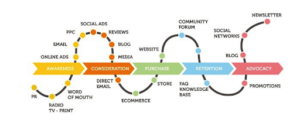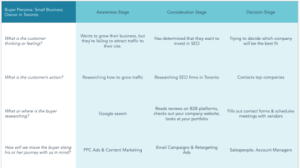How to Create an Effective Buyer Journey Map
A buyer journey is the process that potential customers go through from when they first begin their search to when they make a purchase.
Generally, digital marketing companies like to visualize this as a funnel, but the buying process isn’t always linear. Especially in longer buyer processes, there can be a lot of back-and-forth between a vendor and a potential customer.
Mapping your buyer journey helps you visualize each step of the process and understand what customers experience when working with your company.
Through this process, you’ll learn to communicate with your customers more effectively and streamline your sales funnel. By creating a logical flow to your customer journey, you’ll improve your customer experience.
To create an effective buyer journey map, follow these steps:
- Create buyer personas
- Identify touchpoints
- Recognize your customers’ challenges
- Develop visuals
Need help selecting a company?
Based on your budget, timeline, and specifications we can help you build a shortlist of companies that perfectly matches your project needs. Get started by submitting your project details.
Step 1: Create Buyer Personas
A buyer persona is a fictional representation of your customers that you create based on market data and research. It should include demographic information, interests, and behavioral traits for the different types of customers your company works with.
It’s necessary for you to identify multiple buyer personas because not all of your customers have the same needs. You can identify different buyer personas by segmenting your existing customer base, digging into their demographics, gathering information on their companies, and asking specific questions about their goals and challenges.
To get started, look through your contacts and create a spreadsheet that breaks down your customers’ information. Consider details such as:
- Position or title
- Age
- Spending power
- Company size (particularly if you’re in the B2B industry)
- Interests
- Challenges
This should help you recognize patterns and start to group together the types of buyers who work with you.
A great way to gather more information about a buyer persona is to interview your customers and prospects. This strategy in particular can help you gather less tangible information like what challenges they’re trying to solve, what their goals are, and how they view their relationship with your company. You can also lean on customer data stored in your CRM.
Once you’ve conducted a few interviews, summarize your findings. Share what you’ve learned about each persona’s motivations. A final buyer persona should look like this:

Source: Stratwell
At the same time, try to determine if one of your buyer personas could be an ideal customer profile. This will help you target audiences that are more likely to buy your products and services.
Step 2: Identify Touchpoints
Touchpoints are all the ways buyers interact with your company. They don’t have to be direct, in fact, many buyers may come across your company online first through social media, blogs, paid ads, or third-party review sites.
Each touchpoint plays a role in your customer’s journey throughout the marketing funnel — from the awareness stage through engagement, consideration, conversion, and retention, you need to make sure that you’re properly nurturing your leads so they move from one stage to the next.
For this exercise, focus on one buyer persona at a time. To identify touchpoints, think about how your potential customers gather information at different points of the buying process.

Source: Freshdesk
To understand how people are interacting with your company, take stock of your digital marketing efforts:
- Do you invest in paid ads?
- How much organic traffic does your site attract?
- Have you created an email marketing campaign?
- What digital direct marketing efforts do you use?
Do a quick Google search of your company or use Google Analytics to determine the sources of your website’s traffic, what keywords your site ranks for, and identify backlinks.
From there, identify the resources in your company that are dedicated to creating the customer experience. This can include anyone from content marketers to salespeople and customer service representatives.
Their jobs are to support the customer throughout the buying process. Make sure that the messaging that they use addresses the questions that your customers have at each stage of the process.
Customers at the beginning of the buying process are looking for general information, while customers further into their buying journey are more interested in specific examples and data.
For example, if a small business is looking to grow traffic to their website, an SEO firm can get their attention with PPC ads or articles explaining how investing in SEO can impact their bottom line. However, customers further along in the process need more specific information like project cost. This may require you to update your pricing and product description content to better support your customers and drive engagement further.
Step 3: Recognize your Customers’ Challenges
While you’re mapping your buyer journey, ask yourself what is preventing your customers from converting? In order to increase retention rates, you want to make sure that your process is seamless.
While you’re reviewing your sales process, use this time to identify your customers biggest pain points and remedy them. Remember, the more difficult it is for a customer to move from the awareness stage to purchase, the less likely they are to convert. You can improve the customer experience by:
Answering your customers’ questions in the content you post online
Improving your site’s navigation by investing in user interface or user experience (UI/UX) design
Utilizing call-to-actions to guide customers to product pages or other content of interest
Reducing the number of steps they have to take to buy your products and/or services
Ask your customers what they struggle with most and brainstorm ways to simplify the process.
Step 4: Develop Visuals
Creating visuals can help you understand each step of a customer journey. At any stage, you should be able to identify:
- What the buyer wants to achieve
- How they’re conducting their research
- How you can meet their needs
Here, we created a buyer persona (small business owner in Toronto) and used HubSpot templates to map out their buyer journey for hiring an SEO firm.

Source: HubSpot Templates
At first, the small business owner wants to address their main problem: attracting traffic to their site. So, they conduct a simple Google search. An SEO firm that has written extensively about how search engine optimization can help companies grow traffic might grab their attention, helping the buyer decide that they want to bring on an SEO partner.
As the small business owner conducts more research and weighs different options, they move into the consideration phase. Here, the SEO firm’s touchpoints could be online reviews, retargeting ads, or even email campaigns.
Once the small business owner contacts their list of top partners, they’ve moved into the decision phase: who will they choose to partner with? Now your sales team and account managers can provide more detailed information like pricing.
Develop Buyer Journey Maps to Improve the Customer Experience
Mapping your buyer journey can help you streamline your sales funnel, create a logical flow to the buying process, and, consequently, improve your customer experience.
By creating buyer personas, you’ll be able to address your customers’ unique needs and help you target different demographics.
For each buyer persona you create, consider how they came across your company and what keeps them engaged. Known as touchpoints, this is how potential buyers gather information and make their decisions. Make sure that your messaging answers their questions and helps them move forward through the funnel.
While you’re reviewing the buyer journey, take stock of the challenges your customers face. By reducing friction in the buying process, you can make the buyer journey more efficient.
Finally, develop visuals so that at any point, you know what potential buyers want and how you can meet their needs. With a solid understanding of how they move from awareness to the decision making stage, you can provide a superb customer experience.
Need help selecting a company?
Based on your budget, timeline, and specifications we can help you build a shortlist of companies that perfectly matches your project needs. Get started by submitting your project details.